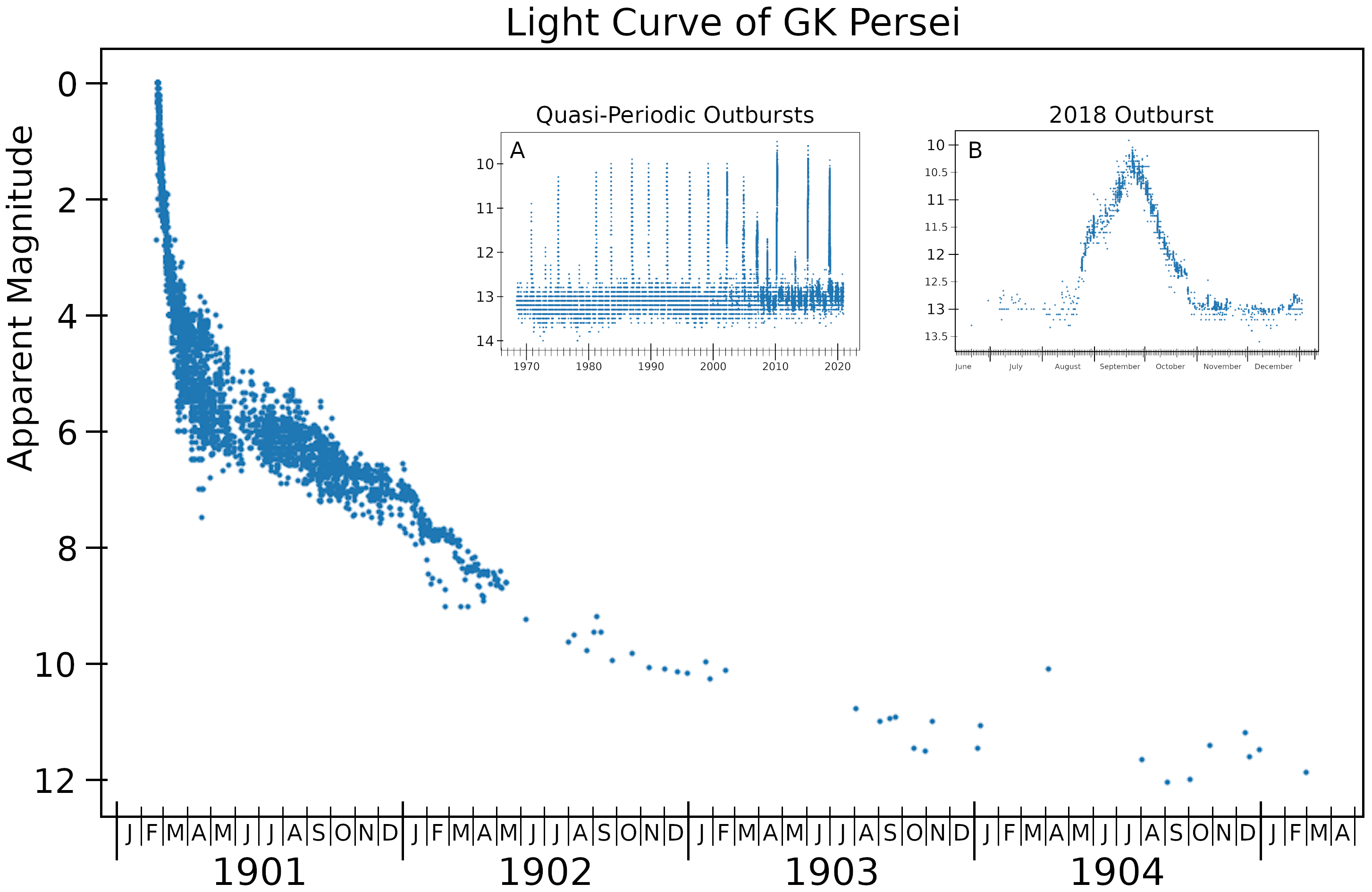GK Persei on:
[Wikipedia]
[Google]
[Amazon]
GK Persei (also Nova Persei 1901) was a bright nova first observed on Earth in 1901. It was discovered by Thomas David Anderson, an  GK Persei has precise parallaxes reported from Gaia DR2 and Gaia EDR3, but these are thought to be badly affected by the binary nature of the system. The
GK Persei has precise parallaxes reported from Gaia DR2 and Gaia EDR3, but these are thought to be badly affected by the binary nature of the system. The
File:GKPerLocation.png, The location of GK Persei (circled in red)
File:Nova Persei 1901.jpg, GK Persei by the 32-inch Schulman Telescope at the Mt. Lemmon Observatory.
File:Expanding nebula around GK Persei.gif, Expanding Nebula around GK Persei. Images range from 1953 to 2012.
File:Drawing of the first observed light echo.gif, alt=Changing light-echo observed at the time of the 1901 Nova, hand-drawn by G.W. Ritchey at the Yerkes Observatory. First image is from 20 September 1901. Second image (with letters a-f) is from 13 November 1901., Changing light-echo observed at the time of the 1901 Nova, hand-drawn by G.W. Ritchey at the Yerkes Observatory.
GK Persei
from the AAVSO
APOD: GK Per: Nova of 1901
2011 November 5
GK Persei by Chandra
Video showing the expansion of the nova remnant
{{DEFAULTSORT:GK Persei Novae Nova remnants Perseus (constellation) 1901 in science 19010221 Persei, GK B-type stars Intermediate polars K-type subdwarfs 1057 021629 K-type subgiants
Edinburgh
Edinburgh is the capital city of Scotland and one of its 32 Council areas of Scotland, council areas. The city is located in southeast Scotland and is bounded to the north by the Firth of Forth and to the south by the Pentland Hills. Edinburgh ...
clergyman, at 02:40 UT on 22 February 1901 when it was at magnitude 2.7. It reached a maximum magnitude of 0.2, the brightest nova of modern times until Nova Aquilae 1918. After fading into obscurity at about magnitude 12 to 13 during the early 20th century, GK Persei began displaying infrequent outbursts of 2 to 3 magnitudes (about 7 to 15 times quiescent brightness). Since about 1980, these outbursts have become quite regular, typically lasting about two months and occurring about every three years. Thus, GK Persei seems to have changed from a classical nova like Nova Aquilae 1918 to something resembling a typical dwarf nova-type cataclysmic variable star.
Surrounding GK Persei is the Firework Nebula, a nova remnant first detected in 1902 consisting of an expanding cloud of gas and dust bubbles moving up to 1200 km/s.
 GK Persei has precise parallaxes reported from Gaia DR2 and Gaia EDR3, but these are thought to be badly affected by the binary nature of the system. The
GK Persei has precise parallaxes reported from Gaia DR2 and Gaia EDR3, but these are thought to be badly affected by the binary nature of the system. The Hubble Space Telescope
The Hubble Space Telescope (HST or Hubble) is a space telescope that was launched into low Earth orbit in 1990 and remains in operation. It was not the Orbiting Solar Observatory, first space telescope, but it is one of the largest and most ...
has used a different method to derive the distance to GK Persei using nebular expansion velocity and compares that with its own astrometric parallax calculation. This gave a somewhat smaller parallax (larger distance) than the Gaia measurements.
Properties
Novae consist of a main-sequence to giant star that accretes mass onto awhite dwarf
A white dwarf is a Compact star, stellar core remnant composed mostly of electron-degenerate matter. A white dwarf is very density, dense: in an Earth sized volume, it packs a mass that is comparable to the Sun. No nuclear fusion takes place i ...
. The two stars of GK Persei orbit each other with a period of nearly 2 days. The white dwarf, with a mass of , has one of the highest masses measured in a cataclysmic variable. The donor star, having donated much of its mass to the white dwarf, is only despite being a subgiant star.
Gallery
References
External links
* http://www.daviddarling.info/encyclopedia/N/Nova_Persei_1901.html * http://lheawww.gsfc.nasa.gov/users/mukai/iphome/systems/gkper.htmlGK Persei
from the AAVSO
APOD: GK Per: Nova of 1901
2011 November 5
GK Persei by Chandra
Video showing the expansion of the nova remnant
{{DEFAULTSORT:GK Persei Novae Nova remnants Perseus (constellation) 1901 in science 19010221 Persei, GK B-type stars Intermediate polars K-type subdwarfs 1057 021629 K-type subgiants